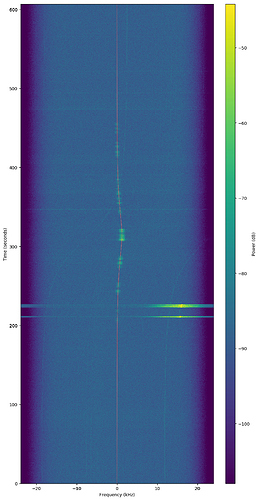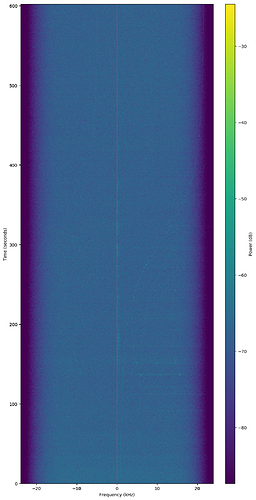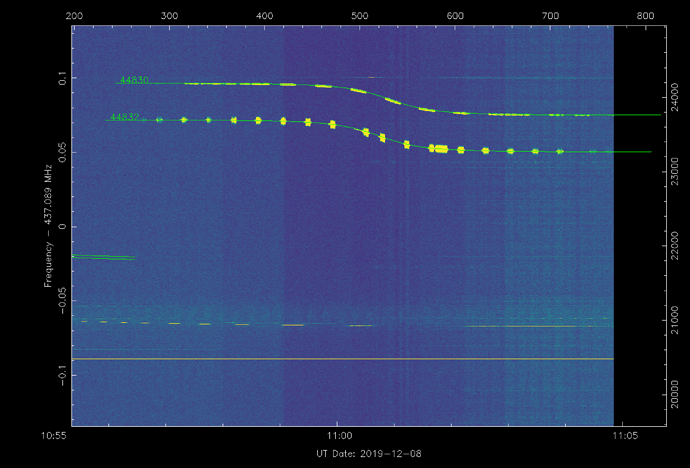The LoRa packet is going to be ~125 kHz wide, not the 10 kHz seen in that screenshot.
Mark, thanks to the notes. I didnot take attention to the used bandwith.
There was an issue with the TLE update, so the most observations the last ~10h used the initial TLE instead of 44827 and 44828 ones.
The issue is now solved and TLEs are updated without problem.
New NORAD IDs to follow:
ATL-1 and Smug-P seems to fit better 44832 object, so now the follow these TLE in network.
FossaSat-1 doesn’t have many good observations, I’ve moved it to follow 44831 object in network.
TRSI-Sat not received, I’ve moved it also to follow 44831 in network.
ATL-1 is described better by NORAD ID 44830:
Smog-P is described better by NORAD ID 44832:
Unfortunately no update from FossaSat-1 or TRSI-Sat, I’ll keep both on 44831, if there is any other suggestion for those two please let me know.
Hi Fredy!
There might be a frequency shift in the TRSI sat.
I flashed an earlier board with the latest firmware, and it´s TXing at 437.319 MHz.
The old board doesn´t have a good crystal, but even in worst case it should be 20kHz off and not 244kHz.
I´ll investigate the issue and will give you an update.
Should we add a transmitter at 437.319MHz and schedule some observations?
I’ve had a look on the latest observation (running in parallel with this obs: https://network.satnogs.org/observations/1331765/ ) using STRF data. SMOG-P and ATL-1 showing clearly (and pretty close together in time) so I’d expect TRSI and Fossasat-1 to show up in the same time window.
Nothing observed from Fossasat-1 or TRSI-Sat. I’ve had a look up/down in frequency and still couldn’t spot anything.
We’ve still recieved FOSSASAT-1 RTTY at 21:56 UTC today, it seems like the signal is very weak though. Only very directional antennas with an LNA and overhead pass it seems. Most Satnogs antenna wont pick it up.
I’ve got an overhead pass tonight that should hopefully have a reasonable shot of picking it up: https://network.satnogs.org/observations/1331767/
That station also saves and uploads IQ data, which will end up here probably 15 min after the observation has finished: https://satnogs-iq.s3-ap-southeast-2.amazonaws.com/1331767.raw
Very weak FOSSASAT-1 signal observed in this observation: https://network.satnogs.org/observations/1333240/
The TLE and frequency seems good, but the signal was too weak to be able to decode in Fldigi.
No need. All clear!
I checked pre-flight recordings of the tests, and the center frequency is pinpointed on 437.075
The backup-beacon however might be near 437.057 - if it´s possible to add this frequency, it would be highly appreciated (Backup beacon shall work only in daylight passes, as it has its own solar cell and radio).
That should just appear in the passband of an observation on 437.075 MHz, so if it’s present, it should be visible in the waterfall at least.
Just had a good overhead pass ( SatNOGS Network - Observation 1331767 ) , nothing sighted around the expected TRSI frequencies in STRF… sorry.
We’ve just seen some more RTTY picked up on these observations:
https://network.satnogs.org/observations/1333261/ (higher power than previous observation)
https://network.satnogs.org/observations/1333264/ (very weak)
It seems like antennas have not deployed and we are trying to get that fixed from earth. Systems seem to remain healthy on decoded packets.
I’ve changed TLE of FossaSat-1 to follow NORAD ID 44829, it seems that describes a little better the signals we have seen until now. However still not having too many good observations to say for sure, also the objects still are too close.
The rest satellites are kept to follow the same NORAD IDs as before.
For the TLE we follow in network for the pocketqubes there are no updates from spacetrack for a couple of days now. This makes difficult to identify the satellites and assign them a NORAD ID.
Updated TLE for SMOG-P and ATL-1 from PA0DLO:
From our observations and the latest TLE from spacetrack, we can confirm PA0DLO findings:
So, SMOG-P now is identified with NORAD ID 44832 and ATL-1 with NORAD ID 44830.
For FossaSat-1 and TRSI-Sat we keep the temporary NORAD IDs for now and we use 44829 and 44831 respectively for TLEs.


